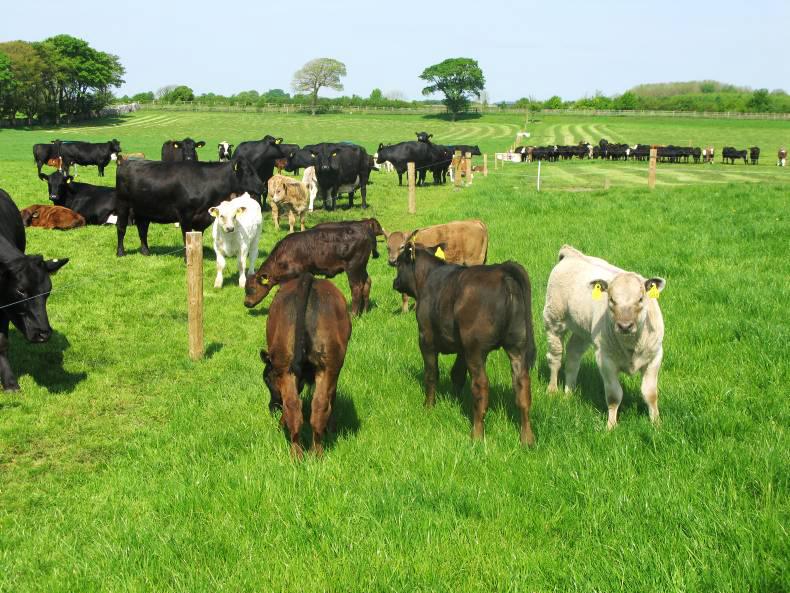The explosion in grass growth rates over the last week has helped get grass supplies back on track after a difficult spring. The rate of the increase with growth rates last week hitting 132kg DM/ha in Newford Farm required some swift changes to planned grazing management.
Farm manager Matthew Murphy said: “The growth we got over the last week was something else. Everything clicked and we benefited from having plenty of nitrogen (N) out (100 units/acre).
“We went from a situation where growth (70kg DM/ha) was running slightly ahead of demand (53kg DM/ha) and we were considering taking out a couple of paddocks to suddenly seeing growth more than double demand and taking out about 32 acres of paddocks for baling,” he said.
Paddocks were taken out of the rotation after analysing the grass wedge, with swards in excess of 2,000kg DM/ha to 2,200kg DM/ha (12cm+) mowed, allowed to wilt for 24 hours and then baled.
This was carried out in this manner to allow paddocks to immediately re-enter the grazing rotation.
“We thought early in the spring that we would have a significant part of the pit left over and we ended up having to buy in 10 bales to tide us over. It didn’t look at all likely three to four weeks ago that we would be cutting silage the second week of May, but the 70 bales in the yard are a welcome surprise and are needed to boost planned fodder supplies,” said Matthew.
Adam Woods explains a focus on driving grass growth will remain in place over the coming weeks, with the aim to replenish supplies and build a fodder reserve for winter.
Fertiliser is being applied after grazing and baling of surplus paddocks at a rate of 25 units per acre and with demand relatively low at 53kg DM/ha, grass surpluses will continue to develop. This is reflected in Figure 1, which shows the grass wedge as of Tuesday afternoon.
Growth rates are also likely to benefit from forecast heat and rain. The only downside to this is if there is too much rainfall and it affects excellent utilisation currently being achieved.
Paddocks are being grazed down to 3.5cm to 4cm, with permanent paddocks temporarily divided with pigtail posts and electric wire, which is also greatly aiding grazing management.
Animal performance
All animals were weighed on 29 April. Performance of yearling cattle over the winter and since turnout is detailed in Table 1.
Weight gain was limited this spring after the delayed turnout and difficult weather, but is starting to get back on track. Performance of 2016-born bull and heifer calves is detailed in Table 2.
Matthew says that calf thrive has really taken off in the last 10 days, with calves benefiting from a boost in cow milk yield. Cows have also benefited from the spike in grass growth, with the higher nutritional intake helping breeding.
There were 18 more cows inseminated in the last week, bringing the total since breeding began on 30 April to 70 head out of a potential of 85 cows put forward.
Cows continue to be inseminated daily at noon to reduce labour. Cows that are still in standing heat the evening after insemination are inseminated again the following day.
Breeding will continue for four more weeks, after which stage-two stock bulls will be joined for four weeks.
Newford Farm national open day
Newford Farm, the 100-cow suckler-to-beef demonstration farm located on the outskirts of Athenry, Co Galway, will host a national open day on Wednesday 25 May. The event, which runs from 2pm to 7pm and has farm walks starting every half hour, will give visitors a chance to see the production system in action.
The suckler enterprise has attracted high levels of interest, with the first-cross Aberdeen Angus and Hereford cows bred from the dairy herd a break from the norm on Irish suckler farms.
The fact that all progeny on the fragmented 55.8ha farm are brought through to beef with the aim of finishing predominately off grass at 18 to 22 months of age is also in contrast to most finishing systems.
Farmers will have the opportunity to see how the farm is focused on implementing management practices that lend itself to being run with one labour unit, farm manager Matthew Murphy, while still aiming to produce high output from a grass-based production system.
Key discussion points
Cow type – what attributes must a cow possess to be profitable. Milk, fertility, production efficiency, longevity and docility are the central pillars on which the herd is based.
The production system – for farmers to replicate, the system must be profitable. The farm plan, including the physical and financial targets, will be explained.
Breeding programme – every cow rearing a calf with good weight for age is the backbone of the system. Hear about how AI is used in a 100-cow herd and why easy-calving continental sires are the perfect fit. Also, not to forget, the farm is contract rearing its replacements.
Grassland management – the farm is stocked at about 2.7LU/ha, putting immense pressure on grass demand. See what decisions and changes to infrastructure have been made.
Herd health – when a system is running at peak performance, extra pressure is often placed on health. A comprehensive herd health plan will be explained in detail.
Other attractions
Representatives from key industry organisations, such as Bord Bia, the Irish Cattle Breeding Federation and Dept of Agriculture, Food and the Marine, along with representatives from drivers of the project Dawn Meats, Teagasc, Irish Farmers Journal (McDonalds also backing the initiative) will also be in attendance.
Farmers will also get the chance to talk to Dawn Meats procurement personnel as part of a live exhibition on drafting animals and market specifications for Newford’s beef cattle.






 This is a subscriber-only article
This is a subscriber-only article













SHARING OPTIONS: